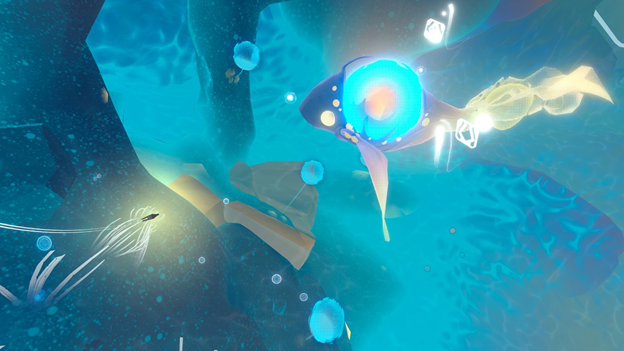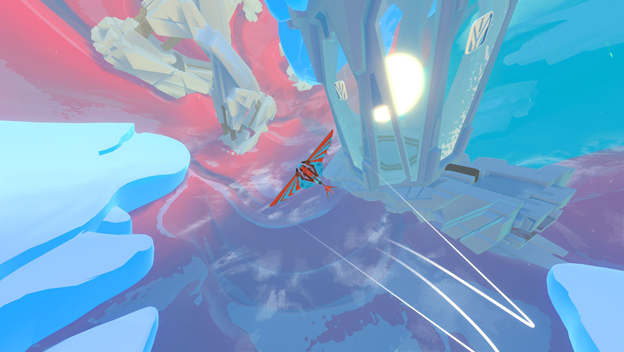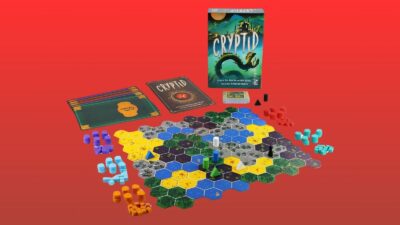This article previously appeared on Crossfader
I’ve always found flight in video games to be a relaxing experience, which is why it so strange to me that it is almost exclusively utilized in stressful scenarios. Hardcore flight sims can see you spend 20 minutes flipping hundreds of switches just to get your aircraft off the runway, while more arcade-like experiences are mostly relegated to chaotic dogfights. There are precious few titles that are content to let you fly free for the fun of it, which was why I was so excited to get my hands on INNERSPACE.
In the vein of JOURNEY or ABZU, INNERSPACE bills itself as an “exploration” game. As “The Cartographer,” an AI-controlled glider brought back to life in the ruins of a long-vanished civilization, your sole mission is to chart the path towards new lands. There is very little plot or activity outside of flying around the environment. Fortunately enough, the act of flying is enjoyable to the point that little else is needed.
More than any other game, however, INNERSPACE reminds me of last year’s GRAVITY RUSH 2, another flight-centric collectathon that launched in January. Both games feature a bright, colorful aesthetic that is very easy on the eyes, though INNERSPACE utilizes a much more minimalist art style. Also similar to GRAVITY RUSH, each of INNERSPACE’s areas contain secret passages, hidden relics, additional aircraft, and an abundance of “Wind” orbs to collect. Discovering these objects composes the majority of the roughly five-hour playthrough, and it’s enough to keep the player occupied for the duration.

The Sunfish is your friend, but only for a whale
That being said, INNERSPACE does suffer a bit of an identity crisis. The canvas shares the simplified palette of JOURNEY, but uses it in a context that is far more complicated in comparison. INNERSPACE features characters, dialogue, and lore that say a lot more than they show. It’s no WAR & PEACE, but it’s enough that I found myself taking the game’s explanation of my surroundings at face value, rather than assigning my own interpretation. Conversely, what narrative that does exist here is so sparse in actual content that I have to wonder why it was included in the first place. The story feels obligatory, like it was added in after the rest of the game was already made, which is odd considering that there is nothing in INNERSPACE that can’t be communicated with visuals alone.
What isn’t communicated so well is where exactly the player is at any given time. Each of INNERSPACE’s arenas is set, appropriately enough, inside of a sphere. Unlike a flat landscape, orienting oneself in such a space is incredibly difficult. There is no center of gravity, nor are there any clearly established directions, meaning that even with landmarks, it’s all too easy to get lost in INNERSPACE. The absence of waypoints or a minimap doesn’t do much to help in this regard, especially in the central hubworld that must be navigated in order to access new areas. Were INNERSPACE larger and longer, such aimlessness could work, but a game this abridged would benefit greatly from stronger player direction.
In addition to normal aerial maneuvers, your craft can also “drift” midair to quickly change direction, as well as transform into a submersible to explore underwater sections. These functions can be upgraded with collected Wind, as can attributes like speed and durability. Without any real challenge or threat to the player, however, there’s no incentive to seek out these permutations. Beyond a few tailing missions, your skills as a pilot are rarely put to the test, and there are no fail states that would encourage the player to increase their performance or change their abilities.

Let the Gogurt-flavored landscapes soothe your nerves
Brevity may be INNERSPACE’s greatest asset, but also its most critical weakness. Were INNERSPACE to last even an hour longer, the charm of its limited toolbox would have overstayed its welcome. On the other hand, the relatively minor issues that I have with it are magnified within such a small package. There are a litany of minor quibbles I have with INNERSPACE that I haven’t yet addressed, primarily due to their banality. Whether by design or glitch, previously explored areas are dimmed, making backtracking for collectibles a struggle. Player health is so high, and colliding with the ground does so little damage, that crashing in a tight space will trap you as your plane erratically pinballs to death, a frustrating situation that could be easily remedied via an airbrake or a reset button.
There are other annoyances like this that I would normally save my breath mentioning in a review due to their insignificance, but there’s so little else about INNERSPACE to discuss that they are impossible to ignore. In the absence of glaring flaws or astounding achievements, I’m forced to delve into the mediocre. Most of INNERSPACE’s ideas are simply half-baked; there’s just too many narrative devices, there’s just not enough to do. These problems don’t break the game, they just prevent it from taking off. Should you find INNERSPACE on sale, there are certainly worse ways to spend an afternoon. In any other case, you’re better off switching flights.
Verdict: Do Not Recommend
Reviewed on PlayStation 4, also available on Xbox One, Switch, and PC.
















Comments